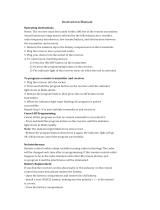
Flex 2JB Standard, AB and Tandem Instruction Manual (FCC/CE)
July 20 2022
Page 2 of 14
PRODUCT MANUAL SAFETY INFORMATION
Advanced Radiotech Corporation (ARC) offers a broad range of radio remote control product for
material handling applications. This manual has been prepared by ARC to provide information and
recommendations for the installation, use, operation and service of ARC’s material handling products
and systems (ARC Products). Anyone who uses, operates, maintains, services, installs or owns ARC
Products should know, understand, and follow the instructions and safety recommendations in this
manual for ARC Products.
The recommendations in this manual do not take precedence over any of the following requirements
relating to cranes, hoists lifting devices or other material handling equipment which use or include
ARC Products:
Instructions, manuals, and safety warnings of the manufacturers of the equipment where the
radio system is used.
Plant safety rules and procedures of the employers and the owners of facilities where the
ARC Products are being used.
Safety standards and practices for the industries in which ARC Products are used.
This manual does not include or address the specific instructions and safety warnings of these
manufacturers or any of the other requirements listed above. It is the responsibility of the owners,
users and operators of the ARC Products to know, understand and follow all of these requirements. It
is the responsibility of the employer to make its employees aware of all of the above listed
requirements and to make certain that all operators are properly trained. No one should use ARC
Products prior to becoming familiar with and being trained in these requirements and the
instructions and safety recommendations in this manual.
WARRANTY INFORMATION
For information on ARC’s product warranties, please contact ARC representative nearest to you or
visit www.advanced-radiotech.com.
FCC WARNINGS and CAUTIONS
This device complies with part 15 of the FCC Rules. Operation is subject to the following
two conditions:
(1) This device may not cause harmful interference, and
(2) this device must accept any interference received, including interference that may cause
undesired operation of the device.
(b) For a Class B digital device or peripheral, the instructions furnished the user shall include
the following or similar statement, placed in a prominent location in the text of the manual:
This equipment has been tested and found to comply with the limits for a Class B digital device,
pursuant to part 15 of the FCC Rules. These limits are designed to provide reasonable protection
against harmful interference in a residential installation. This equipment generates, uses and can
radiate radio frequency energy and, if not installed and used in accordance with the instructions,
may cause harmful interference to radio communications. However, there is no guarantee that
interference will not occur in a particular installation. If this equipment does cause harmful
interference to radio or television reception, which can be determined by turning the equipment off
and on, the user is encouraged to try to correct the interference by one or more of the following
measures:
— Reorient or relocate the receiving antenna.
— Increase the separation between the equipment and receiver.
— Connect the equipment into an outlet on a circuit different from that to which the receiver is
connected.
— Consult the dealer or an experienced radio/TV technician for help.
Any changes or modifications not expressly approved by the party responsible for compliance






















